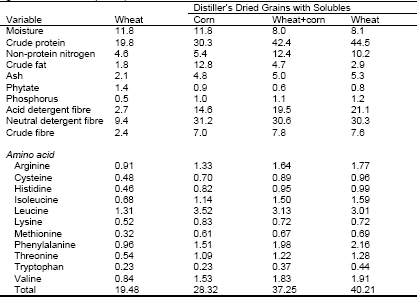



Nutritional Value of Corn and Wheat Distiller's Dried Grain
By G. P. Widyaratne and R. T. Zijlstra and published by the Prairie Swine Center - DDGS is primarily a by-product from the cereal grain-based ethanol industry. With the growth of the ethanol industry, increasing quantities of DDGS are available for livestock rations. However, the potential of DDGS in swine industry is not fully realized because of the scarcity of information on its nutritional value for swine.
Summary
Nutritional value of corn, wheat+corn (4:1) and wheat distiller’s dried grains with solubles (DDGS) for grower-finisher pigs was evaluated. Corn DDGS had the highest digestible energy (DE) and ileal digestible lysine contents but the digestible phosphorus (P) content was similar among DDGS samples. Following characterisation of its digestible nutrient profile, DDGS still resulted in reductions in growth performance, suggesting that either the reduced average daily feed intake (ADFI) or other nutritional factors for DDGS deserve further investigation to ensure a successful implementation of DDGS in swine diets.
Introduction
In general, DDGS has higher concentrations of nutrients such as protein, fat, vitamins, minerals, and fibre than its parent grain. These nutrients are concentrated due to the removal of most of the cereal starch as ethanol and carbon dioxide during the fermentation process. Wheat and corn DDGS are potential feed ingredients for the swine industry, although DDGS is presently not an important ingredient in western Canada.
Experimental Procedure
Digestibility Study: Digestibility and digestible contents of energy, amino acid (AA) and P in DDGS were determined, using 12 barrows fitted with ileal T-cannulae. Pigs were fed a wheat-based control diet or one of three diets with 40% corn, wheat+corn or wheat DDGS in two periods in a controlled cross-over design. Diets were fed twice daily at 2.6 x maintenance. After a 6-d acclimation, faeces was collected for 3 d, and ileal digesta for 2 d.
Performance Study: A total of 100 grower pigs in 20 pens were fed a wheat-pea control diet or one of three diets with 25% corn, wheat+corn or wheat DDGS for 5 wk. Average daily gain (ADG), ADFI, and feed efficiency (G:F) were determined on weekly basis, for a total of five observations per diet.
Results and Discussion
The chemical and nutritional properties varied among the three DDGS samples. Despite the equivalent or higher total nutrient content, nutrient digestibility was lower for the DDGS than the wheat, except for P, which had a digestibility higher for DDGS than wheat. Nevertheless, the digestible contents of nutrients of interest were higher for DDGS than for the wheat. Finally, DDGS inclusion reduced growth performance of pigs, without affecting feed efficiency.
Conclusion
Overall, the results of this study indicate that the complex carbohydrate profile appears to be a major constraint to the nutritional value of DDGS for pigs due to its influence on feed intake, retention time, and the digestion of energy and other nutrients. Further, the nutritional value of DDGS might be enhanced by improving the AA balance through supplementation with limiting AA like lysine, in synthetic form and concomitant reduction of high fiber level with supplementary enzymes.
Acknowledgements
Program funding was provided by Sask Pork, Alberta Pork, Manitoba Pork and Saskatchewan Agriculture and Food Development Fund. The Agriculture Development Fund of Saskatchewan Agriculture, Food and Rural Revitalization funded the project.



Source: Prairie Swine Centre - May 2005








